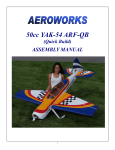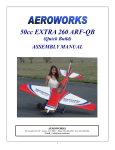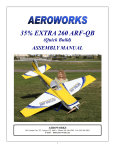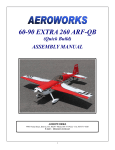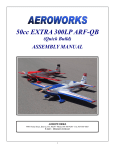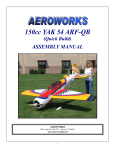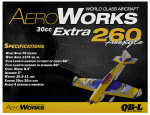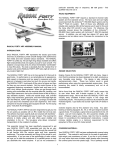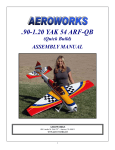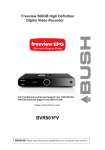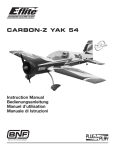Download ASSEMBLY MANUAL
Transcript
50cc YAK-54 ARF-QB (Quick Build) ASSEMBLY MANUAL AEROWORKS 401 Laredo St. Unit “D” - Aurora, CO. 80011 www.aero-works.net 1 TABLE OF CONTENTS Page Aeroworks Contact Information …………………………………………………………........ 3 Introduction …………………………………………………………………………………….. 4 Kit Contents……………………………………………………………………………………… 5 Items Needed To Complete ……………………………………………………………………… 7 Tightening and Re-shrinking the Covering / Check all Seams and overlaps for good seal… 8 Wing Assembly………………………………………………………………….……………… 9 Stab and Elevator Assembly…………………………………………………………………… 14 Rudder and Tail wheel Assembly ………………………………………………………………. 18 Main Landing Gear Assembly ……..………………………………………………………… 30 Engine, Throttle, Mufflers, Tank, and Cowl Installation……………………………………. 35 Radio Installation ………………………………………………………………………………. 71 Preflight Preparation …………………………………………………………………………… 73 2 401 Laredo Unit D Aurora, CO 80011 Phone: (303) 366-4205 Fax: (303) 366-4203 Website: www.aero-works.net E-mail: [email protected] Thank you for choosing the Aeroworks YAK-54 ARF-QB. We put great effort into making this plane the best model you will ever build and fly. We provide you with the highest quality kit and performance possible. We wish you great success in the assembly and flying of your new Aeroworks YAK-54 ARF-QB. WARNING An R/C aircraft is not a toy! If misused, it can cause serious bodily harm and property damage. Fly only in open areas, and AMA (Academy of Model Aeronautics) approved flying sites. Follow all instructions included with your plane, radio, and engine. Aeroworks Manufacturing guarantees this kit to be free from defects in both material and workmanship at the date of purchase. This warranty does not cover any component parts damaged by use or modification. In no case shall Aeroworks liability exceed the original cost of the purchased kit. Further, Aeroworks reserves the right to change or modify this warranty without notice. In that Aeroworks has no control over the final assembly or materials used for final assembly, No liability shall be assumed nor accepted for any damage resulting from the use by the user of the final user-assembled product. By the act of using the userassembled product, the user accepts all resulting liability. We, as the kit manufacturer, provide you with a top quality, thoroughly tested kit and instructions, but ultimately the quality and fly ability of your finished model depends on how you build it; therefore, we cannot in any way guarantee the performance of your completed model, and no representations are expresses or implied as to the performance or safety of your completed model. 3 INTRODUCTION Your new 50cc YAK-54 ARF-QB is a highly aerobatic airplane. It is capable of both precision and 3-D maneuvers. The aircraft builds easily, quickly, and precisely due to its state of the art CAD design, LASER cut technology, and outstanding hardware included. We hope you enjoy building and flying your YAK-54 ARF-QB. Great care has been taken in both the design and manufacturing of the 50cc YAK-54 ARF-QB to allow for the strongest and lightest construction possible. Only the highest quality materials from the covering, paint, wood and hardware have been used in the construction of this model. The 50cc YAK-54 ARF-QB has been individually hand built, covered and painted by trained and experienced craftsmen with over 25 years of manufacturing experience. Using CAD design, laser cut technology and jig-built assures accuracy in all stages of production. The 50cc YAK-54 ARF-QB is designed for gas engines in the 50cc category. A DA-50 two stroke is shown in the assembly instructions. The aircraft was tested with the DA-50 and has outstanding performance. The final choice of engine is left up to the builder. A computer radio is recommended to allow the pilot to take advantage of the full capabilities of this aerobatic aircraft. IMPORTANT Please read through this manual carefully, before starting the assembly of your new50cc YAK-54 ARF-QB. Inventory and inspect all parts and hardware for any imperfections or damage. Please notify AEROWORKS immediately if there are missing or damaged parts. INTENDED USE This plane should not be regarded as a toy. This is an aerobatic plane and is recommended for pilots who are beyond the trainer-stage and are comfortable with flying an aerobatic sport plane. READ! WARRANTY READ! It is important to notify Aeroworks of any damage or problems with the model within 30 days of receipt to be covered under warranty. If you wish to return this aircraft for any reason a 15% restock fee will be charged to the customer. In addition the customer is responsible for all return shipping cost and all prior shipping cost will not be refunded. Parts will be exchanged or replaced once the original item is returned at the owner’s expense. If you have any problems, please contact Aeroworks. Aeroworks cannot insure the skill of the modeler and can not influence the builder during the construction or use of this aircraft, therefore, will not be accountable for any property damage, bodily injury or death caused by this aircraft. Aeroworks cannot insure the skill of the modeler and can not influence the builder during the construction or use of this aircraft, and therefore The purchaser/operator accepts all responsibility of any and all structural or mechanical failures. 4 KIT CONTENTS painted, installed on the fuselage by (4) 4-40x 16mm hex style bolts (4) 3mm flat washer for the mounting of the canopy (4) #6 bonded washer for the mounting of the canopy (1) Antenna Tube installed (1) Pilot holes pre-drilled for tail wheel assembly MATERIALS LIST FOR 50cc YAK54 Basic Aircraft Parts: Fuselage with vertical fin – covered, firewall fuelproofed: (4) 8-32 blind nuts installed for main landing gear (2) 4-40 blind nuts installed for hatch cover of the landing gear (4) 4-40 blind nuts installed for the mounting of the stab. (4) 4-40 blind nuts installed for the mounting of cowling. Hatch cover for the landing gear installed by (2) 440 x 14mm hex style bolts and (2) flat washers. Canopy base—painted with (4)4-40 blind nuts installed (1) Tinted Canopy—glued on the canopy base and Left Wing with Aileron – covered: 8-32 blind nuts installed for the wing mounting. (2) located pins installed (6) pin point hinges glued (1) Aileron servo string installed (1) Pilot holes pre-drilled for control horn mounting Right Wing with Aileron – covered: 8-32 blind nuts installed for the wing mounting. (2) located pins glued (6) pin point hinges installed (1) Aileron servo string installed (1) Pilot holes pre-drilled for control horn mounting 5 Horizontal Stabilizer with elevator assembly (8) pin point hinges (glued)---covered (2) Pilot holes pre-drilled for control horn mounting #7: (2) 1x1100mm plastic coated pull-pull steel cable. (4) 4-40 Metal R/C links with metal clevises and nuts (4) 3.5x5mm brass pull-pull swaging tubes (6) AL double control horns (24) T2.6x16mm Phillips head mounting screws (12) T2.6X12mm Phillips head mounting screws. Rudder with (5) pin point hinges (not glued) – covered (2) Pilot holes pre-drilled for control horn mounting SUB ASSEMBLIES: #1: (1) Fiberglass Cowling—painted with (4) screws holes (4) 4-40x 16mm hex style bolts for mounting cowling (4) #6 bonded washers for mounting cowling. #8: #2: (1) 5mm 7075 Aluminum Main Landing Gear -- painted (2) 5mm AL Axle Bolts (2) M8 lock nuts (4) 5mm i.d. Wheel Collars with set-screws (2) 80mm Dia. Main Wheels (Lite Type) (4) 4-40x14mm hex style bolts for mounting wheel pants (4) 3mm flat washer for mounting wheel pants (4) 3mm split ring lock washer for mounting wheel pants (4) 8-32x20mm hex head bolts for mounting main landing gear (4) flat washers for mounting main landing gear (4) split ring lock washers for mounting main landing gear. #9: (2) Throttle servo plates (2) Engine mounting template (DA50 and 3W50) (1) Plywood support for the pull-pull of the Rudder (1) 130x70x6mm foam for the Fuel tank. (2) 300x80x6mm foam for the receiver and battery (1) 100x30x6mm silicon plate for the muffler mounting (8) Nylon Ties for the fuel tank mounting (1) 5mm i.d. x260mm silicon tube (1) 610x20mm Velcro (1) Pipe mount (fuel-proofed) (2) Pipe mounting hardware with M3 blind nuts (2) 4-40x20mm Hex head bolts (2) 3mm flat washers (2) 3mm split ring lock washers. (1) Balsa former to close off tunnel—painted and fuelproofed #3: (2)Wheel Pants—1 Left and 1 Right---Painted (4) 4-40blind nuts installed on the wheel pants, 2 per side. #10: (24) 6mm aluminum engine stand offs. 750cc Gas Fuel Tank assembly 450cc Gas Fuel Tank assembly (smoke) 4’ large gas fuel line #11: (1) 600x300mm True Red Covering (1) 300x300mm White Covering (1) 300x300mm Midnight Blue Covering (1) 300x300mm Dark Yellow Covering (1) 200x100mm Clear Ultracote for sealing the gaps of the hinge line. #4: (1) AL Tail Wheel Assembly – Medium #5: (1) 32mm o.d. Aluminum Tube for wing joint— Anodized (2) 12.5mm o.d. Aluminum Tube for stab joint – one front and one rear, Anodized. (2) 8-32x25mm Hex head bots for wing mounting (2) #8 bonded washer for wing mounting (4) 4-40x16mm Hex head bolts for stab mounting (4) #6 bonded washers for stab mounting #12: (12) 4-40 ball linkages with Lock nuts / 4-40 Bolts (6) Brass spacer #13: (1) Custom throw meter #6: (2) 4-40 2-1/2” two end threaded pushrod with nuts for elevator (2) 4-40 3” two end threaded pushrod with nuts for ailerons. (2) 4-40x250mm one end threaded pushrod for throttle and choke (2) 4-40 solder coupler (2) 4-40 metal threaded clevis #14: Vinyl Decal Set #15: (1) Manual on CD 6 ITEMS NEEDED TO COMPLETE Hardware: • • • • • • • • • • • • • • • • • • • • • • • • • • • • • • • 50 CC Gas engine and ignition Pitts Muffler or header with canister or pipe Mounting bolts, lock nuts, and washers. 3 1/2” Spinner (P51) Style and propeller 2 x aileron servos (min 180 in./oz Digital, Metal geared) 1 x rudder servo (min 180 in./oz Digital, Metal geared) 2 x elevator servos (min 180 in./oz Digital Metal geared) 1 x throttle servo (fast / Reliable) Servo extensions 2 x 6,” 3 x 12,” 2 x 18” 2 x 36” 1 8 channel receiver ( PCM recommended) 1 x receiver battery (min 4.8 volt / 1700ma) 1 x ignition battery (min 4.8 volt / 1700ma) 2 x switches/charge jacks Allen wrenches US and Metric. Dremel cutting disc and sanding drum tool Electric drill and selection of bits Razor saw Flat head screwdriver Hobby heat gun Hobby iron Masking tape Modeling knife Needle nose pliers or crimping tool Paper towels Pen, pencil or felt tipped marker Phillips screwdriver Rubbing alcohol Ruler and tape measure Scissors T pins Waxed paper Adhesives: Tools: • • • • • • • 7 15-30 Minute epoxy Blue Lock-tite Epoxy mixing cups, sticks, brushes CA kicker (optional) Thick, thin and medium CA Rubbing alcohol Wipes TIGHTENING AND RE-SHRINKING THE COVERING 1. Open your kit slowly and take care not to damage any parts of the kit. Remove all parts from their plastic protective covers for inspection. Before doing any assembly or installation of any decals it is very important to re-shrink or retighten the already applied covering. Due to the shipping process, heat and humidity changes from different climates, the covering may become lose and wrinkle in the sun. If you take the time to re-tighten the covering, you will be rewarded with a long lasting beautifully covered model. 3. If bubbles persist, use a small pin to punch holes in the bubble to relieve trapped air and reheat. 4. Use your heat gun with extreme caution. Take care not to apply too much heat to one area for long periods of time. This may cause the trim colors to over shrink and pull away leaving unsightly gaps on the color lines. The trim stripes are especially vulnerable to over shrinking. 2. Using your covering iron with a soft sock, gently apply pressure and rub in the covering. If any bubbles occur, your iron may be to hot. Reduce heat and work slowly. IMPORTANT Go over any and all seams and color overlaps with your iron to assure good adhesion of the covering to the wood. This is especially important at the Leading edges of the wings and stabs. 5. Your model is covered with Ultracote covering. In case of repairs, the colors are: Midnight Blue Dark Yellow True Red White #885 #889 #866 #870 Tightening and re-shrinking the covering is now complete. 8 WING ASSEMBLY 1. The ailerons have been pre-hinged and glued to the wing panels and are ready for flight. No other steps are necessary for hinging. Clear Ultracote has been provided for sealing of the hinge gaps if desired. Gather one wing panel, one aileron servo, and one 18” servo extension as shown below for servo installation. 2. Layout the servo and extension on the wing to test fit the installation and ensure servo extension is the correct length. Recommended servo: 180 in oz min torque - Metal geared - Digital 3. Attach the 18” extension to the servo lead and secure with safety wire, string, tape, or other method. Ensure the plugs will not come apart from vibration or light tension. 4. Fasten the pull string from the servo hole to the male plug of the servo extension. Secure with tape so that the strings pulls from the front end of the plug. Taper the tape to avoid hang-ups inside the wing. 9 5. Draw the 18” servo extension through the wing and pull through the wing root rib. 7. Remove servo and use a 1/16 bit to drill servo mounting holes. 6. Install servo in servo well with the output arm toward the leading edge of the wing and mark locations of servo mounting holes. 8. Install servo with servo mounting screws. 10 9. Aileron servo mounted in bottom of wing. 2. 3. Use a ruler against the outboard side of the servo case to project a line to the leading edge of the aileron and mark as shown. Aileron Control Linkage Installation 1. Assemble the pushrod and control horn assembly as shown. The ball link goes between the left and right sides of the control horn sides and is secured with a nylon lock nut. Start with the center hole in the control horn. The ball link may be moved up or down for more or less control throw. Gather the aileron control linkage parts as shown below. There is 1 pushrod, 2 ball link assemblies, 1 left and 1 right side control horn, and 6 wood screws for each wing panel. Note: The control horn mounting holes may have been factory drilled for you. If so, go to the next step. 11 3. From that mark measure 1/2” toward the wing tip and mark the leading edge of the aileron as shown. This mark will be the center of the aileron control horn. Note:The control horns have been purposely offset from 90 degrees to servo arm to allow for full servo strength at full deflection Note: The control horn mounting holes may have been factory drilled for you. If so, go to the next step. 5. Use a 1/16” bit to drill the control horn mounting holes. 4. 6. Mount the control horn using six wood screws as shown. Note: The control horn mounting holes may have been factory drilled for you. If so, go to the next step. Tape the inboard trailing edge of the aileron to the trailing edge of the wing in the neutral position. Plug the servo into the receiver and turn on. Ensure the servo is centered and the servo arm is parallel to the aileron hinge line. Attach front ball link to servo arm. Adjust the length of the pushrod so that the leading edge of the control horn is aligned with the leading edge of the aileron. Center the control horn over the mark as shown and mark the position of the control horn mounting holes. Note: Use thin CA to lock screws in place 12 7. Ensure the servo does not bind at either end point at full deflection. A 1” servo arm is recommended for best results. A 1 1/4” servo arm is required for full deflection of the aileron 55º bevel. The control horns have been purposely offset from 90 degrees to servo arm to allow for full servo strength at full deflection 8. Repeat all the above steps for the other wing. 13 STAB AND ELEVATOR ASSEMBLY Elevator Servo Installation 1. 3. Feed the servo wire through the pre-cut elevator servo well and out the root rib of the stab as shown. 4. Install servo in servo well with the output arm toward the leading edge of the stab and mark locations of servo mounting holes. The elevators have been pre-hinged and glued to the stabs and are ready for flight. No other steps are necessary for hinging. Clear Ultracote has been provided for sealing of the hinge gaps if desired. Gather the stabs and elevators, two elevators servos, and two 36” servo extensions as shown below. 2. Gather the elevator control linkage parts as shown below. There are 2 pushrods, 4 ball link assemblies, 4 metal threaded RC links, 2 left and 2 right side control horns, and 12 wood screws for each stab and elevator. Recommended servo 180 in oz min torque - Metal geared - Digital 14 5. Remove servo and use a 1/16 bit to drill servo mounting holes. Elevator Control Linkage Installation 1. 6. Install servo with servo mounting screws. Assemble two pushrod and control horn assemblies as shown. The ball link goes between the left and right sides of the control horn sides and is secured with a nylon lock nut. 2. Use a ruler against the outboard side of the servo case to project the line to the leading edge of the elevator and mark as shown. Note: The control horn mounting holes may have been factory drilled for you. If so, go to the next step. 15 3. From this mark measure 1/2” toward the stab tip and mark the leading edge of the elevator as shown. This mark will be the center of the elevator control horn. 5. Use a 1/16” bit to drill the control horn mounting holes. Note: The control horn mounting holes may have been factory drilled for you. If so, go to the next step. Special Note: The control horns have been purposely offset from 90 degrees to servo arm to allow for full servo strength at full deflection 4. Tape leading edge of the elevator balance tab to the leading edge of the stab in the neutral position. Plug the servo into the receiver and turn on. Ensure the servo is centered and the servo arm is parallel to the elevator hinge line. Attach front ball link to servo arm. Adjust the length of the pushrod so that the leading edge of the control horns are aligned with the bottom leading edge of the elevator. Center the control horn over the mark and mark the 6. Mount the control horn using six wood screws as shown. A 1 1/2” servo arm is recommended to achieve full deflection of the elevator bevel. Note: Use thin CA to lock screws in place 16 7. Plug the servo wire into the female end of the 36” extension and secure the servo plugs with safety wire, string, tape, or other method. Ensure the plugs will not come apart from vibration or light tension. 8. Ensure the servo does not bind at center or either end point at full deflection. 9. Repeat the above steps for the other stab and elevator. 17 RUDDER AND TAILWHEEL ASSEMBLY Rudder Installation 1. Gather the rudder, six hinges and epoxy materials as shown. Use 15-30 minute epoxy to ensure adequate working and cleanup time. 2. Prep all hinges for installation by applying Vaseline petroleum jelly or light oil to the hinge joint. This ensures no epoxy gets into the hinge during assembly. 18 3. Mix epoxy in mixing cup and use a tapered stick to apply the epoxy inside the pre-drilled holes in the trailing edge of the fin. Apply epoxy to one side of each hinge and insert the hinge completely into the hole. Ensure the hinge axis is vertical and parallel to the trailing edge of the fin before epoxy cures. Wipe away excess epoxy with alcohol wetted wipes. 4. Epoxy the hinges into the fin first and allow epoxy to fully cure. 5. Mix epoxy in mixing cup and use a tapered stick to apply the epoxy inside the pre-drilled holes in the leading edge of the rudder. Apply epoxy to trailing edge of each hinge. 6. Carefully slide the rudder onto each hinge and against the trailing edge of the fin. Wipe away excess epoxy with alcohol wetted wipes. 7. Ensure there is no gap between fin and rudder. Rudder Servos Installation 1. Gather one rudder servo as shown below. Recommended servo 180 in oz min torque - Metal geared - Digital 19 2. Install the rudder servo in the forward servo cutout with the output shaft to the rear. 3. Mark and use a 1/16 bit to drill the rudder servo mounting holes. 4. Install rudder servos with servo screws. Rudder Pull-Pull Cable Installation 1. 20 Gather the rudder control linkage parts shown below. Rudder cable, 2 ball link assemblies, 4 threaded metal RC links, 4 threaded couplers, 4 brass swaging tubes, 2 left and 2 right side control horns, and 12 wood screws. 2. Gather the rudder control linkage parts shown below. 2 Rudder cables, 2 threaded metal RC links, 4 threaded couplers, and 4 brass swaging tubes. 4. Insert rudder cable through the brass swage tube, then through the threaded coupler hole, and back through the brass swage tube as shown. 3. Feed the rudder cable through the cable exit tube in the tail of the fuse toward the front of the fuse. Repeat on other side. 5. Loop the cable back through the brass swage tube as shown. 21 6. Crimp the brass tube with a crimping tool or pliers. 8. Tighten the second loop through the brass swage tube and crimp the brass tube with a crimping tool or pliers. Cut off excess cable as shown. 7. If additional crimping is needed a small CClamp may be used for additional crimping pressure. 9. A drop of thin CA may be applied to the swage tube to help secure the cable 10. Repeat above steps for the other side rudder cable. 22 11. Attach a metal threaded RC link to each threaded coupler. Attach the RC links to the rudder servo arm and then attach the servo arm to the rudder servo as shown. A 2 3/4” to 3” arm is recommended. 2. Measure up from the bottom of the rudder 1 1/4” and place a mark on the rudder leading edge. Note: The control horn mounting holes may have been factory drilled for you. If so, go to the next step. 3. Center the rudder control horn over the mark and mark the locations of the control horn mounting holes. Rudder Control Horn Installation 1. Gather the rudder control horn parts as shown below. 2 ball link assemblies and 2 left and 2 right side control horns. Assemble the ball links between the control horns as shown. Secure with nylon lock nut. Note: The control horn mounting holes may have been factory drilled for you. If so, go to the next step. 23 4. Use a 1/16 bit to drill control horn mounting holes. 7. Plug the rudder servo into the rudder channel of the receiver and power up. Turn on transmitter to center rudder servo. 8. Tape the rudder balance tab to the top leading edge of the vertical fin in the neutral position as shown. This ensures the rudder is straight when the cables are attached. Note: The control horn mounting holes may have been factory drilled for you. If so, go to the next step. 5. Mount rudder control horns using six wood screws. 6. Repeat the above steps for mounting the other side rudder control horn. 24 9. Remove ball links from the rudder control horns. Attach two threaded couplers to ball links as shown. 11. Attach ball link to rudder control horn on both sides of the rudder. Thread the rudder cable through a brass swage tube, then the threaded coupler, and back through the brass swage tube on both sides. Pull light tension on the cable through the coupler on both sides as shown. The loop through the coupler should be approximately 1/2” long. 10. Hold the threaded coupler below the cable attach holes to thread into the ball link as shown. Do not hold coupler at the top where the cable hole is located. This may cause burrs on the coupler that can eventually cut the rudder pull cable. 12. Loop the cable back through the brass swage tube as shown. 25 13. Tighten the second loop through the brass swage tube as shown. 15. A drop of thin CA may be applied to the swage tube to help secure the cable. 14. Crimp the brass tube with a crimping tool or pliers. 16. Hold the threaded coupler below the cable attach holes to thread into the ball link as shown. Do not hold coupler at the top where the cable hole is located. This may cause burrs on the coupler that can eventually cut the rudder pull cable. 26 17. 18. Attach ball link to rudder control horn on both sides of the rudder. Tail Wheel Installation Adjust rudder pull-pull cables to desired tension by screwing in or out on the threaded couplers and or ball links. Make all adjustments with the rudder servos still powered up and centered, and the rudder still taped in the neutral position. Ensure the servo does not bind at center or at either end point. 27 1. Gather the tail wheel parts shown below. Tail wheel strut and leaf spring, 3 tail wheel mounting screws, steering tiller, 2 mounting screws, and 2 steering springs. 7. Apply a drop of thick CA to the mounting screws before inserting in the holes. 8. Mount the tail wheel steering tiller using two wood screws. 10. Mount the tail wheel struts and springs using three wood screws. 9. Place the tail wheel spring on top of the tail wheel strut. Position the tail wheel and spring on the bottom of the fuse. Place a drop of thick CA on tail wheel strut mounting screws before inserting in the pre-drilled mounting holes on the bottom rear of the fuse. 11. Attach the steering springs on both sides of the tail wheel to the rudder tiller and tail wheel tiller. Center the springs between both tillers. 28 13. Use pliers to twist spring ends closed around the tillers after desired tension and direction adjustments are complete. 14. Tail wheel final assembly is complete. 29 MAIN LANDING GEAR ASSEMBLY Main Landing Gear Installation 1. Gather the landing gear parts as shown below. Landing gear strut, 4 mounting bolts, washers, and lock washers, 2 wheels, 2 axles, and 4 collars as shown below. 2. Gather the gear strut, 4 mounting bolts, washers, and lock washers, as shown below. 30 3. Remove landing gear cover from fuse by removing the two screws from the front former. 4. Note that the trailing edge of the landing gear strut is tapered. The tapered edge goes toward the rear of the fuse. 5. Use a drop of blue lock-tite on landing gear bolts before attaching the landing gear. 7. Use a drop of blue lock-tite on landing gear cover bolts before attaching the landing gear cover. 6. Bolt landing gear strut to fuse with 4 bolts and washers. Ensure tapered edge of the gear strut is facing toward the rear. 8. Reinstall the gear cover. 31 Wheels and Wheel Pants Installation 1. Gather the wheels, axles, and collars as shown below. 2. Use a drop of blue lock-tite on landing gear axle bolt before attaching the landing gear axle with the nylon lock nut. 32 3. Install the axle into the gear strut with nylon lock nut but DO NOT tighten. 4. Snug axle to gear strut with the flat sides vertical. Align axle with wheel pant slot. 5. Slide wheel pant over axle and install the wheel pant mounting bolts to hold the wheel pant in alignment but do not tighten wheel pant bolts. 7. Remove the wheel pant and use wrenches to permanently tighten the axle to the gear strut. 6. Tighten the axle so it does not rotate during final tightening. 8. Install the inner wheel collar next to the axle bolt. Tighten the inner wheel collar in place. Install the wheel and outer wheel collar. Use blue lock-tite on the wheel collar set screw before final tightening. 33 9. Wheel mounted on center of the axle. 11. Install wheel pants with two mounting bolts. 10. Slide the lock washer then the flat washer on the wheel pant mounting bolts. Use blue locktite on the bolts before final tightening. 12. Repeat above steps for other wheel and wheel pant. 34 ENGINE, THROTTLE, MUFFLERS, TANK, AND COWL INSTALLATION Engine Installation 1. 3. It is recommended to center punch the location of the engine mounting holes prior to drilling. 4. Use a 1/4 drill to drill the engine mounting holes. Locate the laser cut engine mounting template for either the DA-50 or 3W-50. If other engines are used the templates may be modified for any mounting pattern. 2. Line up the template with the firewall thrust lines and mark the location of the engine mounting holes. 35 5. Gather the engine and mounting hardware as shown. 4 mounting bolts, 4 washers and 4 2 1/2”stand offs. Stand offs available thru Desert Aircraft. 7. Insert the bolts through flat fender washers, the firewall and into the engine stand offs. Tighten firmly. 8. Be sure to use flat fender washers on the back side of the firewall to distribute bolt pressure. The required distance from the firewall to the front of the prop hub on the engine is 6 1/4” to 6 1/2” 6. Use a drop of blue lock tite on the engine mounting bolts prior to installing. Due to the high verity of different Engine selections and mounting preferences. Engine mounting hardware is not included. 36 Throttle Servo and Choke Installation 3. Attach the 2-56 ball link to the throttle pushrod and secure to the carburetor throttle arm with a 2-56 bolt and nylon lock nut. 4. The throttle servo is mounted on the side of the fuse that aligns with the engine carburetor throttle arm. Insert the throttle servo into the appropriate throttle servo mounting tray with the output arm forward. Insert the throttle pushrod into the servo arm easy link and dry fit inside the fuse. Align the servo tray so there is no binding on the throttle pushrod. 1. Gather the left and right plywood throttle servo mounting trays, the throttle servo, and pushrod parts as shown below. Due to the wide range of engine and throttle hook up choices. Throttle linkage hardware has not been included. The following steps are recommendations. 2. Use a 1/4 bit to drill a pushrod exit hole in the firewall in line with the engine carburetor throttle arm. 37 5. Mark the location of the servo mounting tray on the fuse side. 7. Install the servo mounting tray to the fuse side aligned with the marks. Keep the pushrod away while allowing the epoxy to cure. 6. Prepare to epoxy the servo mounting tray to the fuse side. Apply epoxy to the back of the servo mounting tray. 8. Insert the servo into the mounting tray and mark the location of the servo mounting holes. 38 9. Use a 1/16” bit to drill the servo mounting holes. 11. Insert the throttle pushrod through the throttle servo easy link. Move the throttle servo arm to the centered position and the pushrod so that carburetor is at half open. Then tighten the easy link set screw. 10. Install the servo using servo screws. 12. Cut off the excess pushrod wire as shown. 39 13. Final throttle servo installation. Muffler, Canister, and Tuned Pipe Installation 1. The following sections describe installation of either the pits style muffler, header and canister, or tuned pipe. Use the steps that apply to the exhaust system you will use. 14. We recommend installing the carburetor choke pushrod as shown. Use nylon ties to provide support and holding friction for the choke pushrod. Place silicon fuel tubing over the wire pushrod to prevent damage from vibration and provide holding friction. You can install a choke servo if desired. Use the same mounting steps as the throttle servo. Muffler and Cowl Installation 1. 40 Use a drop of blue lock-tite on the muffler bolts prior to installation. 2. Install the muffler on the engine exhaust port and tighten securely. 4. Measure 3/16” from the edge of the template. This will allow for the overhang of the cowling to the front former. 3. Gather the following material for making a cowl cutout template. Use a large envelope or cardboard file folder for template material. 5. Mark a line 3/16” from the edge of the template. 41 6. Mark the center of the template as shown below. 8. Tape the template to the bottom of the fuse 3/16” back from the front former and on centerline as shown. 7. Mark a centerline on the bottom of the front former as shown. 9. Hold the template up to the exhaust stacks and trace the location of the exhaust stacks as shown 42 10. Draw a rectangle around the exhaust stack locations and cut it out with a hobby knife. 12. Remove the template and cut out the tracing with a hobby knife. 11. Pull up the template to the engine cylinder head and muffler can. Trace around the engine cylinder and muffler can so that they can extend below the template after the tracing is cut out. 13. With template centered and flush with rear of cowl tape the template to the cowling. Cut the template to clear the air intake on the bottom of the cowl and allow the template to lay flat against the bottom of the cowl. 43 14. Tape the template flat against the bottom of the cowl and trace the opening onto the cowl as shown. 16. Dry fit the cowl and make any adjustments to the cut out as necessary. Install the cowl using the four cowl mounting bolts and rubber backed washers. 15. Use a rotary cutting tool to cut out the opening in the bottom of the cowl. 17. Final cowl installation with engine muffler. 44 Header and Canister Muffler Installation 1. Measure the length of the header and canister from the center of the header mounting flange to the rear of the canister and add 1 inch. 3. Transfer this distance to the bottom of the fuse starting from the center of the engine cylinder head. Gather the header and canister muffler parts as shown below. 1 header, coupler, clamps, and canister assembly, plywood mounts, silicon tubing, silicon rubber, and canister holding bracket with screws. Canister Tunnel Preparation 1. 2. Iron the bottom covering to ensure it is tight and well sealed to the wood. 45 4. Dry fit the header and canister to the bottom of the fuse and ensure there is one inch of space from the line just marked to the rear of the canister. 6. Use a hobby knife to remove the covering from the rear of the landing gear cross brace to the mark between the two bottom fuse stringers. 5. Draw a line across the fuse belly on the mark location as shown. This will be the location of the rear former of the canister tunnel. 7. Use a hobby knife to remove the covering from the front former to the front of the landing gear cross brace as shown. 46 8. Covering material removed from two bottom fuse bays. 10. Use a razor saw to remove the cross braces just behind the landing gear from the canister tunnel 9. Use a razor saw to remove the front former cross brace across the canister tunnel. 11. Cross braces removed from canister tunnel. 47 12. Dry fit the header and canister inside the tunnel and ensure there is clearance on all sides. 14. Dry fit the canister tunnel rear former inside the rear of the canister tunnel. Tilt the bottom of the former slightly to the rear at the bottom of the fuse as shown. This will allow the air flow to exit easily. 13. Locate the pre-painted balsa canister tunnel rear former as shown below. 15. Mark the bottom of the fuse line on the former and mark the top of the canister tunnel where the former makes contact. 48 16. Use a hobby knife to cut the former to fit the bottom of the fuse. 18. Apply CA glue to the sides and bottom to secure the rear canister tunnel former in place. 17. Apply thick CA glue to the top and bottom of the canister tunnel former. 19. Rear canister tunnel former glued in place. 49 20. 21. Iron the bottom covering to securely seal the covering to the bottom of the rear canister tunnel former. Canister Installation Dry fit the header and canister inside the tunnel and ensure there is clearance on all sides. 50 1. Determine the location of the rear canister mounting hanger. This should be approximately two thirds back on the canister or as described in the canister installation instructions and as desired by the builder. Mark this location on the edge of the canister tunnel. 2. Transfer this mark to the top of the canister tunnel. Ensure the mounting holes in the top of the canister tunnel will not interfere with any equipment installed or to be installed inside the fuse. 3. Mark the centerline of the plywood canister mounting bracket. 5. Use a 1/8” bit to drill the canister mounting bracket mounting holes. 4. Align the centerline of the plywood bracket with the mounting location previously marked on the top of the canister tunnel. Mark the location of the canister bracket mounting holes. 6. Locate the two plywood canister mounting doublers with pre-installed blind nuts as shown. 51 7. Slide the canister mounting doublers under the fuel tank mounting tray and align the blind nuts with the mounting holes. The canister mounting doublers are in two pieces to allow easy access. 9. Trace the shape of the canister mounting bracket on the piece of flat silicon as shown. 8. Install the canister mounting bolts from inside the canister tunnel and screw into the blind nuts to hold the doublers in place. Do not tighten. Tack glue the edges of the doublers to the top of the canister tunnel with CA glue. Remove the bolts and glue the doublers securely in place. Do not allow CA glue to get into the blind nut threads. 10. Use a hobby knife to cut the flat silicon rubber to match the size of the canister mounting bracket. 52 11. Locate the pre-drilled counter sunk holes in the plywood canister mounting bracket and the two flat washers as shown below. 13. Use a small piece of medium sand paper to scuff one side of the silicon rubber to ensure a good glue bond. 12. Place the flat washers inside the counter sunk holes as shown. Ensure the washer is fully seated inside the counter sunk holes. 14. Apply thick CA glue to the scuffed side of the silicon rubber piece. 53 16. Glue the silicon rubber piece on top of the counter sunk holes on the plywood canister mounting bracket. This will seal the washers inside the canister bracket mount as shown. 18. Insert the canister mounting bolts through the holes in the canister mounting bracket as shown. 17. After the CA glue has fully cured, use a hobby knife to cut two small round holes in the silicon rubber. The holes should be just large enough to allow the heads of the canister mounting bolts to pass through the silicon rubber and seat against the washers inside. 19. Locate the nylon tie canister mounting strap and the silicon rubber tubing as shown below. 54 20. Use a pair of scissors to split one end of the silicon tubing in half approximately 3/4” deep as shown. 22. Prepare to slide the silicon tubing onto the nylon tie. The split end of the tubing goes opposite the nylon tie lock a shown. 21. After splitting the silicon tubing cut off one side of the split section as shown. This will provide a relief section of the tubing for the nylon tie lock and insulate it from the metal canister surface. 23. Slide the silicon tubing onto the nylon tie as shown to form the canister strap assembly. 55 24. Place the canister strap assembly in the canister tunnel as shown. Allow the nylon tie lock to extend out of the tunnel 1/1/2” as shown. 26. Cinch the nylon tie around the canister tube and tighten securely. Ensure that the nylon tie does not touch the metal surface of the canister tube and is properly insulated by the silicon tubing as shown below. 25. Place a drop of blue locktite on each canister mounting bolt. Then place the canister mounting bracket over the canister mounting strap and insert the two mounting bolts through the top of the canister tunnel and into the blind nuts on the opposite side. Tighten the mounting bolts securely. 27. Cut off excess tie as shown. 56 28. Bottom view of the final canister installation. Tuned Pipe Tunnel Preparation Header and Tuned Pipe Installation 1. Gather the header and tuned pipe parts as shown below. 1 header, coupler, clamps, and tuned pipe assembly. 57 1. Iron the bottom covering to ensure it is tight and well sealed to the wood. 2. Use a hobby knife to remove the covering from the front former to the front of the landing gear cross brace as shown. 3. Use a hobby knife to remove the covering from the landing gear cross brace to the preinstalled rear tuned pipe former as shown. 5. Use a razor saw to remove the cross braces just behind the landing gear from the tuned pipe tunnel. 4. Use a razor saw to remove the front former cross brace across the pipe tunnel. 6. Covering and cross braces removed from tuned pipe tunnel. 58 7. 8. Iron the bottom covering to securely seal the covering to the bottom of the rear tuned pipe tunnel former. Tuned Pipe Installation Dry fit the header and tuned pipe inside the tunnel and ensure there is clearance on all sides. 59 1. Determine the location of the rear tuned pipe mounting hanger. This should be approximately two thirds back on the pipe or as described in the pipe installation instructions and as desired by the builder. Mark this location on the edge of the tuned pipe tunnel. 2. Transfer this mark to the top of the tuned pipe tunnel. Ensure the mounting holes in the top of the pipe tunnel will not interfere with any equipment installed or to be installed inside the fuse. 3. Mark the centerline of the plywood pipe mounting bracket. 5. Use a 1/8” bit to drill the pipe mounting bracket mounting holes. 4. Align the centerline of the plywood bracket with the mounting location previously marked on the top of the pipe tunnel. Mark the location of the pipe bracket mounting holes. 6. Locate the two plywood pipe mounting doublers with pre-installed blind nuts as shown. 60 7. Trace the shape of the pipe mounting bracket on the piece of flat silicon as shown. 11. Locate the pre-drilled counter sunk holes in the plywood pipe mounting bracket and the two flat washers as shown below. 10. Use a hobby knife to cut the flat silicon rubber to match the size of the pipe mounting bracket. 12. Place the flat washers inside the counter sunk holes as shown. Ensure the washer is fully seated inside the counter sunk holes. 61 13. Use a small piece of medium sand paper to scuff one side of the silicon rubber to ensure a good glue bond. 15. Glue the silicon rubber piece on top of the counter sunk holes on the plywood pipe mounting bracket. This will seal the washers inside the pipe bracket mount as shown. 14. Apply thick CA glue to the scuffed side of the silicon rubber piece. 16. After the CA glue has fully cured, use a hobby knife to cut two small round holes in the silicon rubber. The holes should be just large enough to allow the heads of the pipe mounting bolts to pass through the silicon rubber and seat against the washers inside. 62 17. Insert the pipe mounting bolts through the holes in the pipe mounting bracket as shown. 19. Use a pair of scissors to split one end of the silicon tubing in half approximately 3/4” deep as shown. 18. Locate the nylon tie pipe mounting strap and the silicon rubber tubing as shown below. 20. After splitting the silicon tubing cut off one side of the split section as shown. This will provide a relief section of the tubing for the nylon tie lock and insulate it from the metal pipe surface. 63 21. Prepare to slide the silicon tubing onto the nylon tie. The split end of the tubing goes opposite the nylon tie lock a shown. 23. Slide the pipe mounting doublers under the rudder servo mounting tray and align the blind nuts with the mounting holes as shown. 22. Slide the silicon tubing onto the nylon tie as shown to form the pipe strap assembly. 24. Install the pip mounting bolts from the inside the pipe tunnel and screw into the blind nuts to hold the doublers in place. Do not tighten. Tack glue the edges of the doublers to the top of the pipe tunnel with CA glue. Remove the bolts and glue the doublers securely in place. Do not allow CA glue to get into the blind nut threads. 64 25. Place a drop of blue locktite on each pipe mounting bolt. Then place the pipe mounting bracket over the pipe mounting strap and insert the two mounting bolts through the top of the pipe tunnel and into the blind nuts on the opposite side. 27. Cinch the nylon tie around the tuned pip tube and tighten securely. Ensure that the nylon tie does not touch the metal surface of the tuned pipe tube and is properly insulated by the silicon tubing as shown below. 26. Allow the nylon tie lock to extend out of the tunnel 1/1/2” as shown. Tighten the mounting bolts securely. 28. Cut off excess nylon tie as shown. 65 28. Bottom view of the final tuned pipe installation. Fuel Tank Installation 1. Gather the fuel tank parts as shown below. Fuel tank parts, fuel tubing, and foam rubber. Note: Your fuel tank may differ slightly then pictured 29. Cowl cut out for engine cylinder head with canister and tuned pipe installation. Refer to cowl mounting instructions in the Muffler and Cowl Installation on page 40, steps #1-17. 2. 66 Assemble the fuel tank as shown below. Use large diameter tube for pick-up and small diameter tube for the vent. Secure the fuel tubing with nylon ties to the pick-up tube and clunk. 3. Insert the rubber stopper into the tank with the small diameter vent tube at the top of the tank. Secure the stopper with a nylon tie. 2. Install the fuel tank mounting ties under the fuel tank floor as shown. 3. Install the fuel tank with foam rubber underneath as shown. Cinch the nylon ties securely to hold the tank against the foam on the fuel tank floor. Note: Your fuel tank may differ slightly then pictured Fuel Tank Installation 1. Gather the fuel tank parts as shown below. Fuel tank, fuel tubing, and foam rubber, fuel T and fuel dot, nylon ties. Note: The fuel T and fuel dot are not supplied. 67 4. 5. Install the fuel tubing as shown with small nylon ties. You will need an after market fuel T and fuel filling dot. Note: We recommend looping the vent line to the rear of the fuel tank as shown to prevent fuel spilling when the model tail is lifted or flying a down line. Ignition Installation Install the fuel filling dot as desired on the side of the fuse. Do not allow the fuel dot to interfere with the leading edge of the wing. Secure the fuel vent line to the front former for proper draining. Drill a fuel line hole in the bottom of the engine box floor to allow fuel pick up line to connect the engine carburetor fuel intake nipple. 68 1. Gather the engine ignition parts as shown below. Engine ignition, nylon ties, and foam rubber. 2. Locate the plywood ignition mounting bracket as shown. 3. Use thick CA to glue the ignition mounting bracket to the side of the engine mounting box. 5. Use a 1/8” drill bit to drill the ignition mounting holes. 4. Position the engine ignition on the mounting bracket and mark the location of the nylon tie holes as shown. 6. Mount the engine ignition module using nylon ties and foam rubber as shown. Route the ignition wire to the engine as shown and secure with nylon ties as necessary. 69 4. Install the ignition battery and regulator if required as desired. A typical installation is shown below. Secure all wiring from excess vibration. 70 RADIO INSTALLATION 1. Gather the switches and mounting hardware to be used. We used two switches, one for receiver battery, and one for ignition battery. The installation steps are the same for all switches. 3. Use a modeling knife to cut out the switch holes. 2. Switch location is at the discretion of the builder. We chose to place the switches toward the front of the fuse on each side. Mark location for switches using switch template. 4. Slide switch wires inside fuse through the switch cutout. 71 5. Mount switches in accordance with the switch instructions and hardware. 7. Mount the radio components as desired using the radio tray cutouts. Ensure all wires and plugs are secure and not subject to chafing when routed through the radio tray and formers. 6. Gather the supplied radio mounting hardware as shown below. Foam rubber, Velcro straps, and nylon ties. 8. Typical installation of RC equipment. 72 PRE-FLIGHT PREPARATION 3. Gather the 2 wing mounting bolts and 2 #8 rubber large backed washers. 5. Gather the 4 stab mounting bolts and 4 #6 small rubber backed washers. 6. Slide the stab tube in the fuse stab tube sleeve. Slide the stabs on the stab tube and plug in the elevator servo plugs. Slide the rubber backed washers on the stab mounting bolts and insert bolts through the stab mounting tabs and into the fuse blind nuts. Tighten snugly but do not over tighten and crack the stab mounting tabs or the fuse sides. Always check for good fit of the wing attachment bolts. We recommend using cotter pins through the aluminum anti-rotation dowels for a second method of security. 4. Slide the wing tube in the fuse wing tube sleeve. Slide the wings on the wing tube and plug in the aileron servo plugs. Slide the rubber backed washers on the wing mounting bolts and insert bolts through the fuse side and into the wing root blind nuts. Tighten snugly but do not over tighten and crack the fuse or wing root wood. 73 1. Gather the 4 cowl mounting screws and 4 #6 small rubber backed washers. 7. Gather the 4 hatch mounting bolts and 4 #6 small rubber backed washers. 2. Mount the cowl using the cowl mounting screws and rubber backed washers. The rubber backed washers are to prevent the fiberglass cowl from cracking from normal engine vibration. 8. Slide the rubber backed washers on the hatch mounting bolts and insert bolts through the hatch mounting holes and into the fuse blind nuts. Tighten snugly but do not over tighten and crush the hatch or the fuse sides. 74 Finishing 3. Factory placement of decals. 1. Decals supplied with the kit may vary from the photos below. Cut the pre printed adhesive backed decals from the decal sheet and apply where desired. Clean the model surface with alcohol to allow a good bond to the surface. The decals may be applied using Windex or a solution of 1 drop of dish detergent to a cup of water sprayed on the model to assist in proper positioning. The water must be pressed out from under the decal after the decal is in position. Use a rubber squeegee or a credit card edge to press the water out. 2. Factory placement of decals. 75 Center of Gravity 1. Warning, do not skip this step! 3. Start at recommended CG until you are comfortable with the flight characteristics of the aircraft. You may find this a bit nose heavy at first but that is fine to start with. After you are comfortable adjust the CG to suit your flying style in small steps, especially when shifting the CG toward the tail. Move the battery or add small stick on weights to the nose or tail as necessary. The recommended CG is 4 1/4” back from the wing leading edge at the wing tip as shown. 4. For aerobatic flying a more aft balance point is better. For smooth sport flying a more forward CG is better. An aircraft that is too nose heavy does not fly well and is difficult to land. A tail heavy aircraft is uncontrollable and will likely crash. Control Throws 1. The amount of control throw should be adjusted using mechanical means as much as possible and then electronically with the radio. The control throws are shown in degrees and inches of deflection measured at the widest point of the control surface for both low and high rates. 2. Balance the YAK-54 without fuel in the tank with the batteries installed and ready to fly. The engine, radio, servos, and battery you use will determine the final weight and locations of equipment. Try to balance the model by moving the battery and receiver before adding any ballast. . 2. Aileron throw measured in inches. 76 3. Elevator throw measured in inches. 5. If a flight control deflection meter is available you can measure the throws in degrees. 4. Rudder throw measured in inches. 6. Elevator throw measured in degrees. 77 Control Throw Deflection Table Low Rate Preflight Checks Center of Gravity: Check CG is set properly. High Rate Aileron 2 1/2” or 25˚ up 3” or 30˚ up 2 1/2” or 25˚ down 3” or 30˚ down Rudder 2 1/2” or 35˚ left 3 1/2” or 40˚ left 2 1/2” or 35˚ right 3 1/2” or 40˚ right Engine: The engine should run smoothly at all throttle settings with smooth transition from idle to full throttle without stalling or hesitation. Do not fly an unreliable engine. Read engine instructions including break in and tuning completely. Elevator 1 3/8” or 12˚ up 2” or 18˚ up 1 5/8” or 16˚ down 2 1/4” or 24˚ down Flight Controls: Ensure all flight controls are free from binding and are centered. Check that all hinges are tight and will not pull out. Control linkages must be rigid and tight and have no slop. Confirm proper direction of ailerons, rudder, and elevator. Experienced flyers have lost airplanes due to reversed ailerons. Right roll is right up, left down. Left roll is left up, right down. For 3D flying use the following throws: 3D Rate Aileron 3 1/2” or 35˚ up 3 1/2” or 35˚ down Rudder 6” or 45˚ left 6” or 45˚ right Batteries: Transmitter and receiver batteries are fully charged. Fasteners: Check all wing bolts, hatch bolts, servo screws, control horn bolts, wheel collars, and clevis keepers are tight and secure. Elevator 4 1/2” or 45˚ up 4 1/2” or 45˚ down Radio: Check trims set to neutral and controls centered. Check rate and condition switches set properly. Check the receiver antenna is fully extended and not reversed on it self. We recommend 15% Expo on low rates, 30% expo on high rates, and 60% expo on 3D rates as a starting point. You a can adjust from there to suit your own flying style. Range check: Do a range check with and without the engine running in accordance with the radio manufacturer instructions. If there is insufficient range or a large reduction with the engine running, do not fly until it is resolved! Fuel: Fill the fuel tank before each flight. 78 Aerobatics The 50cc YAK-54 is capable of any aerobatic maneuver. After you gain some confidence and little experience flying the airplane you can cut loose and perform any maneuver you can think of. Here is a list of some of the more popular aerobatic and 3D maneuvers you can try: • • • • • • • • • • • • Loops and rolls Knife edge flight Stall turns Snap rolls 2, 4, and 8 point rolls Slow rolls Spins upright and inverted Flat Spins upright and inverted Harriers upright and inverted Water falls Torque Rolls Rolling circles The sky and your imagination are you only limits. FLY and ENJOY! AEROWORKS 79 YAK-54 NOTES ___________________________________________________________________________ ___________________________________________________________________________ ___________________________________________________________________________ ___________________________________________________________________________ ___________________________________________________________________________ ___________________________________________________________________________ ___________________________________________________________________________ ___________________________________________________________________________ ___________________________________________________________________________ ___________________________________________________________________________ ___________________________________________________________________________ ___________________________________________________________________________ ___________________________________________________________________________ ___________________________________________________________________________ ___________________________________________________________________________ ___________________________________________________________________________ ___________________________________________________________________________ ___________________________________________________________________________ ___________________________________________________________________________ ___________________________________________________________________________ __________________________________________________________________________ 80
















































































